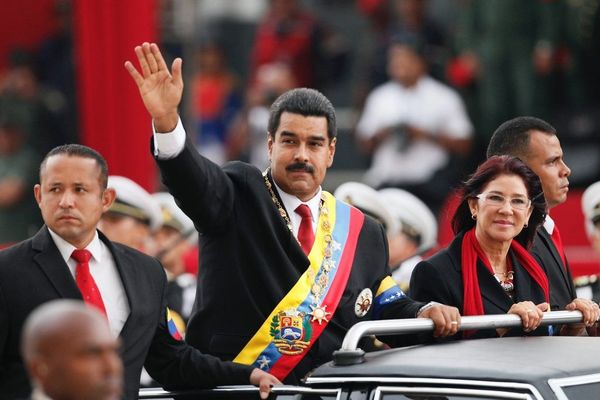President Barack Obama is meeting today with his National Security Council at CIA headquarters to discuss efforts to combat the Islamic State (also known as ISIS or ISIL). This comes as the administration debates ways to fight recent ISIS gains. On the table: an increase in the number of U.S. special operations forces in Syria.
Also today, Syrian President Bashar al-Assad’s regime is holding parliamentary elections in areas under governmental control, mostly in the west of the country. The regime claims this is in line with the constitution, which calls for parliamentary elections every four years. Opposition leaders say the move is an attempt to forestall pressure from the international community ahead of another round of peace talks, scheduled to begin today (although the government has said it will not send its delegation to Geneva until tomorrow).
Assad’s position is clear and, with recent successes on the ground and continued Russian and Iranian support, is unlikely to change. He strongly opposes the kind of transitional government called for in the U.N. Security Council Resolution 2254, which would lead to a complete overhaul of Syria’s current political system, meaning Assad would likely lose his grip on power.
Instead, he favors a unity government that would include opposition members currently not represented in the regime, albeit with Assad still at the helm—think Lebanon’s Taif Agreement of 1989 or Iraq’s power-sharing model after the 2003 U.S. occupation. The power-sharing arrangements formulated in these countries following years of civil war were designed to ensure that members of the various warring groups – Sunnis, Shiites, and Maronite Christians in Lebanon and Sunnis, Shiites, and Kurds in Iraq – would all be represented at the highest levels of government.
Lebanon’s arrangement has largely been seen as a success and an example for the region, while the situation in Iraq quickly deteriorated with former Prime Minister Nouri al-Maliki’s purging of political rivals. The difference could lie in demographics. No single group holds a clear majority in Lebanon; whereas in Iraq, the CIA estimates 60 – 65 percent of the population is Shiite and 32 – 37 percent Sunni. There is also a distinct majority group in Syria, with about 74 percent of the population identifying as Sunni.
If demographics help explain why some power-sharing situations work and why others fail, then a Taif-esque solution does not look good for Syria. The Sunni majority and Kurdish populations are sure to continue feeling misrepresented and oppressed if Assad’s minority Alawites retain any semblance of power. The opposition groups have said their top demand is that Assad is removed from office. Moreover, although Assad says he is open to a government that incorporates the opposition, he has mentioned nothing about whether this would take the form of a true power-sharing arrangement (that is he does not want elections that could throw him out of office).
With the prospect looking dim for any kind of unified power-sharing government, it may be time to seriously consider partitioning Syria, as former NATO Supreme Allied Commander James Stavridis says. Stavridis, who is currently Dean of the Fletcher School of Law and Diplomacy at Tufts University, told The Cipher Brief that although the best solution for the U.S. would be a unified, moderate Syria, the facts on the ground make that option seem unlikely. Hence, negotiators should start talking about partitioning.
U.S. Secretary of State John Kerry alluded to the possibility of partitioning during a U.S. Senate foreign relations committee hearing on February 23. “It may be too late to keep it as a whole Syria if we wait much longer,” he said. Stavridis notes that since then, Kerry has backtracked. Nonetheless, many politicians, experts, and citizens are skeptical about the likelihood of a unified Syria.
“The map of Syria will be dotted with several state-lets with varying degrees of security, autonomy, and local governing capacity, even as the military campaign against ISIS continues. There is no returning to the status quo ante,” say Cipher Brief experts and Carnegie Endowment for International Peace scholars Richard Sokolsky and Perry Cammack. In a conversation with The Cipher Brief, Middle East expert and senior fellow at The Brookings Institution Kenneth Pollack said a peace settlement could result in a divided Syria. “In particular you could have the Alawite community and many of the other minorities in the west become an independent country, and maybe the Sunni dominated communities in the east another country.”
There are two major problems with discussing a partitioned Syria: public perception and ISIS. The idea of external powers redrawing borders is hardly ever palatable, especially in a country that was formed as part of the Sykes-Picot Agreement following WWI. And the thought of dividing a country along ethnic, religious, or political lines is often just as unappealing.
The much bigger issue, however, is ISIS. Former Acting Director of the CIA and Cipher Brief network member John McLaughlin noted that if one wants to even begin to think about a post-conflict Syria, the violence must be stopped. That means defeating ISIS and al-Qaeda’s affiliate in Syria, the al-Nusra Front.
Right now, the Assad regime controls much of Syria’s west, rebel groups are in the northwest and southwest, the Kurds are in the north and east, and ISIS has strongholds throughout. A power-sharing agreement or some kind of partitioning would – given the current landscape of control – have to include ISIS. The opposition forces, the Assad regime, and the international community are adamantly opposed to this. The region’s major players, including the U.S., have two options: sit down with ISIS or defeat the terrorist group. Then, figure out what to do to end the Syrian civil war.













